Liebherr CNES 4056 Manual
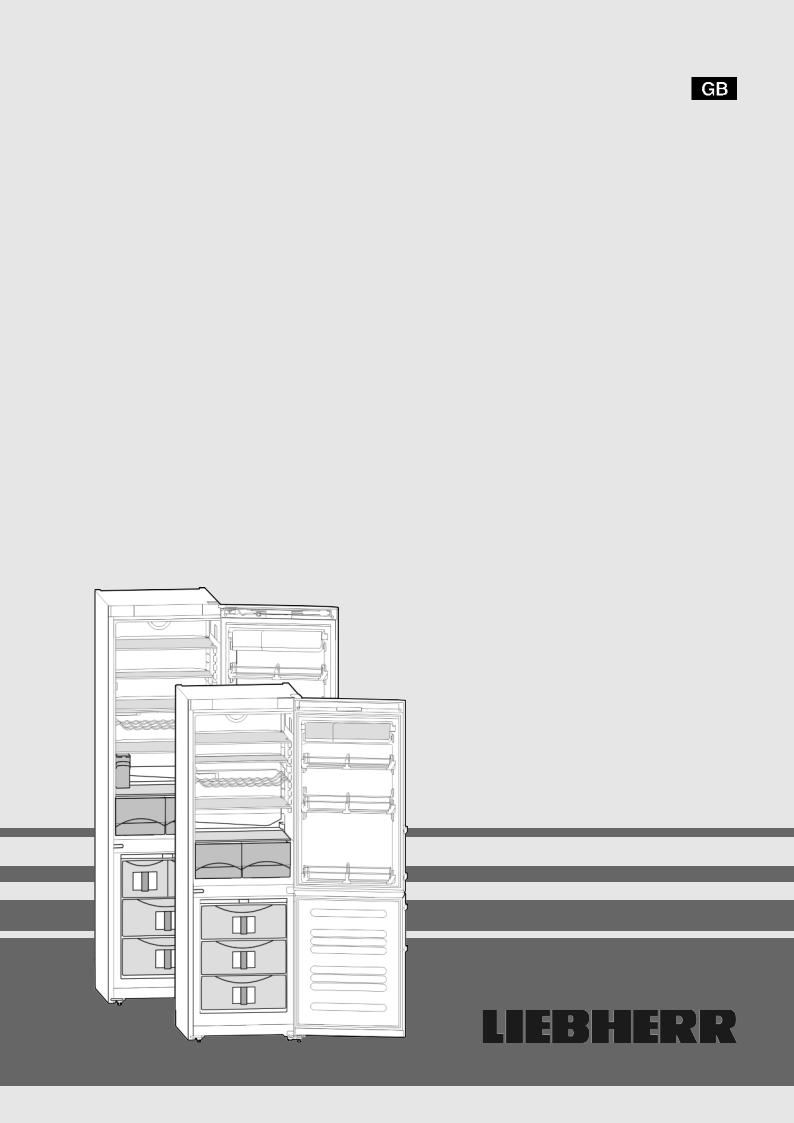
Operating instructions
Combined fridge-freezer
171110 7085014 - 00
CN(es)/ CNP ... 6
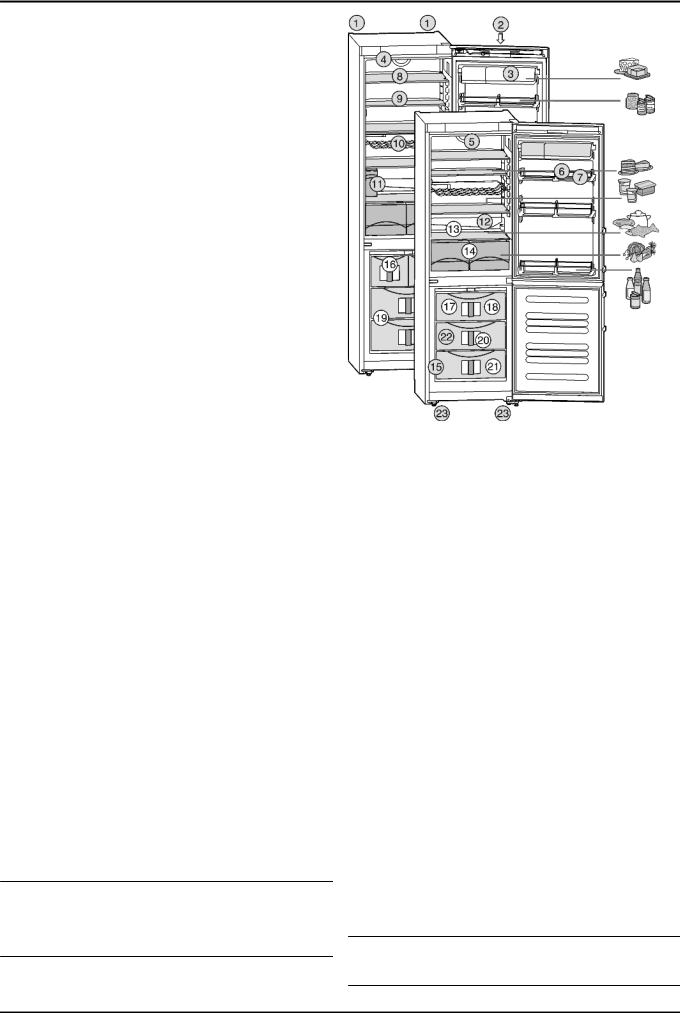
Appliance at a glance
Contents |
|
|
1 |
Appliance at a glance............................................ |
2 |
1.1 |
Description of appliance and equipment.................. |
2 |
1.2 |
Range of appliance use............................................ |
2 |
1.3 |
Conformity................................................................ |
3 |
1.4 |
External dimensions of the appliance....................... |
3 |
1.5 |
Saving energy.......................................................... |
3 |
1.6 |
HomeDialog............................................................. |
3 |
2 |
General safety information................................... |
3 |
3 |
Controls and displays........................................... |
4 |
3.1 |
Operating and control elements............................... |
4 |
3.2 |
Temperature display................................................. |
4 |
4 |
Putting into operation............................................ |
4 |
4.1 |
Transporting the appliance....................................... |
4 |
4.2 |
Installing the appliance............................................. |
4 |
4.3 |
Changing over the door hinges................................ |
5 |
4.4 |
Insertion into a row of kitchen units........................... |
7 |
4.5 |
Disposing of packaging............................................ |
8 |
4.6 |
Connecting the appliance......................................... |
8 |
4.7 |
Switching on the appliance....................................... |
8 |
5 |
Control.................................................................... |
8 |
5.1 |
Brightness of the temperature display...................... |
8 |
5.2 |
Child proofing........................................................... |
8 |
5.3 |
Door alarm................................................................ |
9 |
5.4 |
Temperature alarm................................................... |
9 |
5.5 |
Refrigerator compartment........................................ |
9 |
5.6 |
Freezer compartment............................................... |
10 |
6 |
Maintenance........................................................... |
12 |
6.1 |
Defrosting with NoFrost............................................ |
12 |
6.2 |
Cleaning the appliance............................................. |
12 |
6.3 |
Cleaning the IceMaker............................................. |
13 |
6.4 |
Changing the interior light with bulb.......................... |
13 |
6.5 |
Customer service..................................................... |
14 |
7 |
Malfunction............................................................. |
14 |
8 |
Decommissioning.................................................. |
15 |
8.1 |
Switching off the appliance....................................... |
15 |
8.2 |
Taking the appliance out of service.......................... |
15 |
9 |
Disposing of the appliance................................... |
15 |
The manufacturer works constantly on the further development of all the types and models. Therefore please understand that we have to reserve the right to make design, equipment and technical modifications.
To get to know all the benefits of your new appliance, please read the information contained in these instructions carefully.
The instructions apply to several models. Differences may occur. Text relating only to specific appliances is marked with an asterisk (*).
Instructions for action are marked with a  , the results of action are marked with a
, the results of action are marked with a  .
.
1 Appliance at a glance
1.1 Description of appliance and equipment
Note
u Place food inside the appliance as shown in the diagram. This allows the appliance to save energy during operation.
u Shelves, drawers and baskets are arranged for optimum energy efficiency on delivery.
Fig. 1 |
(12) Drain hole |
|
(1) |
Transport grips at back |
|
(2) |
Operating and control |
(13) Coldest zone |
(3) |
elements |
(14) Vegetable bin |
Butter and cheese |
||
(4) |
compartment |
(15) Type plate |
Interior light |
||
(5) |
Fan |
(16) IceMaker* |
(6) |
Bottle holder, movable |
(17) Cold storage accumulator |
(7) |
Door rack, relocatable |
(18) VarioSpace |
(8) |
Shelf, relocatable |
(19) Information system |
(9) |
Shelf, sectioned |
(20) Ice-cube tray* |
(10) Bottle shelf |
(21) Freezer drawer |
|
(11) Water tank* |
(22) Adjustable feet, transport |
|
|
|
grips at front, transport |
|
|
castors at back |
1.2 Range of appliance use
The appliance is suitable solely for cooling food in a domestic environment or similar. This includes use in, for example
-in staff kitchenettes, bed and breakfast establishments,
-by guests in country homes, hotels, motels and other forms of accommodation,
-in catering and similar services in the wholesale trade
Use the appliance solely as is customary within a domestic environment. All other types of use are inadmissible. The appliance is not suitable for storing and cooling medicines, blood plasma, laboratory preparations or similar substances and products covered by the 2007/47/EC Medical Devices Directive. Misuse of the appliance can result in the stored products suffering harm or perishing. Furthermore, the appliance is not suitable for operation in potentially explosive atmospheres.
The appliance is set to operate within specific ambient temperature limits according to its climate rating. The correct climate rating for your appliance is indicated on the type plate.
Note
u Compliance with the ambient temperatures indicated is required, otherwise the cooling performance is reduced.
2
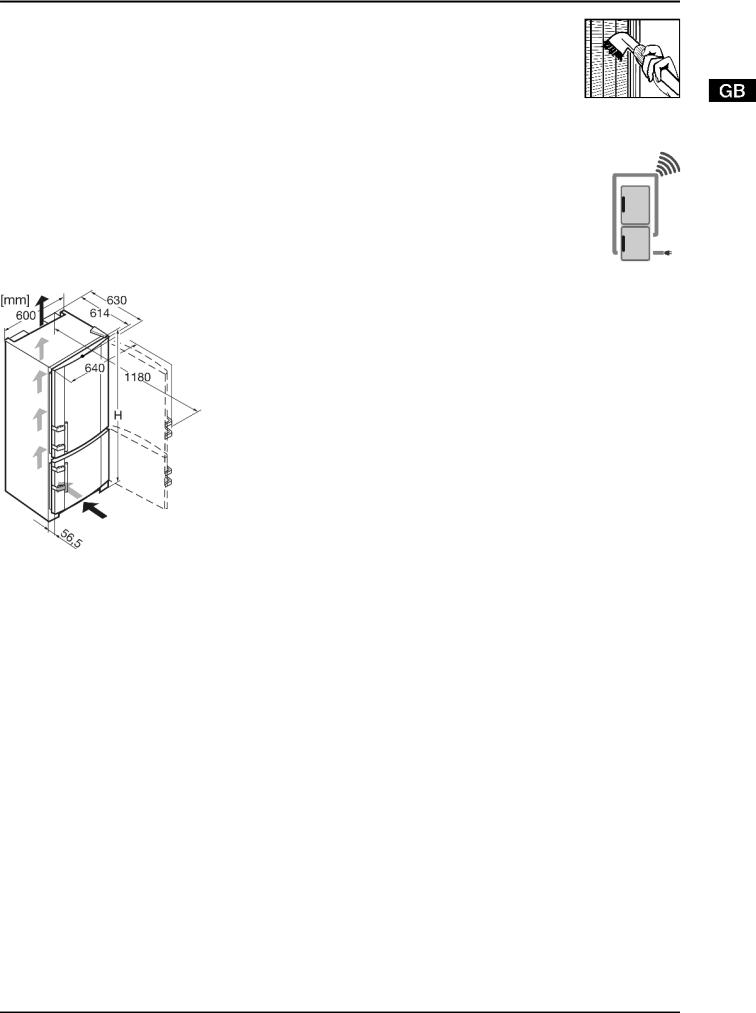
General safety information
Climate |
for ambient temperatures of |
rating |
|
SN |
10 °C to 32 °C |
N |
16 °C to 32 °C |
ST |
16 °C to 38 °C |
T |
16 °C to 43 °C |
1.3 Conformity
The refrigerant circuit has been tested for leaks. The appliance complies with current safety regulations and EC directives 2006/95/EC and 2004/108/EC.
1.4 External dimensions of the appliance
|
Fig. 2 |
|
|
Model |
Height of appliance H (mm) |
CN(es) 35.. |
1817 |
CN 39.. |
2011 |
CN(es) 40.. |
2011 |
CNP 40.. |
2011 |
1.5 Saving energy
-Always ensure good ventilation. Do not cover ventilation openings or grille.
-Always keep fan louvres clear.
-Do not place appliance in areas of direct sunlight or next to a stove, heater or similar object.
-The energy consumption depends on the installation conditions, e.g. the ambient temperature (see 1.2) .
-Keep the time the appliance is open to a minimum.
-The lower the temperature setting, the higher the power consumption.
-Store food logically. (see Appliance at a glance).
-Ensure that all food is well packed and covered for storage. This will prevent frost from forming.
-much.Remove food as needed in order that it does not warm too
-First cool warm food to room temperature before storing it .
-Defrost frozen food in the refrigerator.
-Empty and switch off refrigerating unit for longer vacation periods.
Accumulated dust increases the energy consumption:
-Once a year, dust the refrigerating unit together with the metal grille of the heat exchanger at the back of the appliance.
1.6 HomeDialog
Depending on model and options, the HomeDialog system can be used to network a number of Liebherr appliances (situated, for example, in the basement) with a main appliance (sited, for example, in the kitchen) and control them via the latter. You will find more information on the benefits, requirements and principle of operation on the internet at www. liebherr.com.
2 General safety information
Danger for the user:
-This appliance is not designed for persons (including children) with physical, sensory or mental impairment or persons not having sufficient experience and knowledge, unless they are instructed in the use of the appliance and are initially supervised by a person responsible for their safety. Keep children under supervision to ensure they do not play with the appliance.
-In case of a fault, pull out the mains plug (not by pulling the connecting cable) or switch off the fuse.
-Have any repairs to or intervention in the appliance, and any change of the mains power cable, carried out by the customer service only or by other specialised personnel trained for the purpose.
-When disconnecting the appliance from the supply, always take hold of the plug. Do not pull the cable.
-Install and connect the appliance only as instructed.
-Please keep these instructions in a safe place and pass them on to any subsequent owners.
-All repairs to and intervention in the IceMaker may be carried out only by service personnel or by other skilled personnel trained for the purpose.*
-Special-purpose lamps (incandescent lamps, LEDs, fluorescent tubes) in the appliance serve to illuminate the appliance interior and are not suited for room illumination.
Fire hazard:
-The refrigerant R 600a is environmentally friendly but flammable. Escaping refrigerant may ignite.
•Do not damage the refrigerant circuit pipes.
•Do not allow naked flames or ignition sources to enter the appliance.
•Do not use any electrical appliances in the interior (e.g. steam cleaners, heaters, ice cream maker etc.).
•If refrigerant escapes: eliminate naked flames or sources of ignition from the vicinity. Pull out the power plug. Ventilate the area well. Notify customer service.
-Do not store explosives or sprays using combustible propellants such as butane, propane, pentane, etc. in the appliance. Respective spray cans can be identified by reference to the contents printed on the can or by a flame symbol. Gases possibly escaping may ignite due to electrical components.
-Do not place any burning candles, lamps or other items with naked flames on or in the appliance.
-Only store high-percentage alcohol in tightly sealed, upright containers. Alcohol possibly escaping may ignite due to electrical components.
Danger of tipping and falling:
3
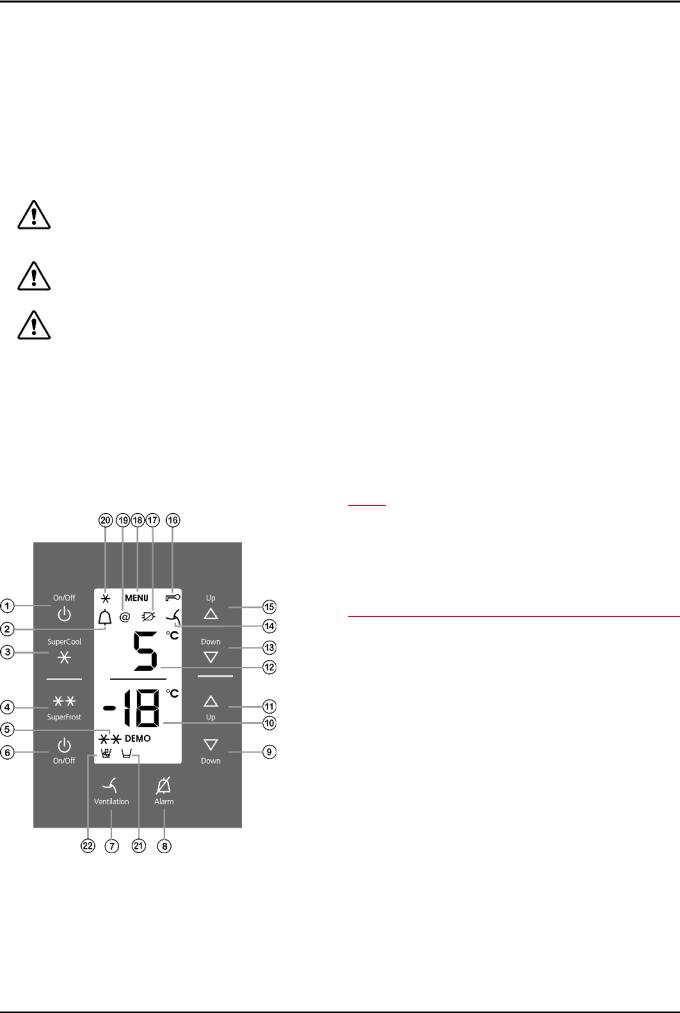
Controls and displays
-Do not misuse the plinth, drawers, doors etc. as a step or for support. This applies particularly to children.
Danger of food poisoning:
- Do not consume food which has been stored too long.
Danger of frostbite, numbness and pain:
-Avoid lasting skin contact with cold surfaces or refrigerated/ frozen food or take protective steps, e.g. wear gloves. Do not consume ice cream, water ice or ice cubes immediately and do not consume them too cold.
Please observe the specific information in the other sections:
|
DANGER |
identifies a situation involving direct |
|
|
danger which, if not obviated, may |
|
|
result in death or severe bodily |
|
|
injury. |
|
WARNING |
identifies a dangerous situation |
|
|
which, if not obviated, may result in |
|
|
death or severe bodily injury. |
|
CAUTION |
identifies a dangerous situation |
|
|
which, if not obviated, may result in |
|
|
minor or medium bodily injury. |
|
NOTICE |
identifies a dangerous situation |
|
|
which, if not obviated, may result in |
|
|
damage to property. |
|
|
|
|
Note |
identifies useful information and tips. |
3 Controls and displays
3.1 Operating and control elements
(1) |
On/Off button, refriger- |
Fig. 3 |
(12) Refrigerator compartment |
||
(2) |
ator compartment |
temperature display |
Alarm symbol |
(13) Down setting button, |
|
(3) |
SuperCool button |
refrigerator compartment |
(14) Fan symbol |
||
(4) |
SuperFrost button |
(15) Up setting button, refriger- |
(5) |
SuperFrost symbol |
ator compartment |
(16) Child-proofing symbol |
||
(6) |
On/Off button, freezer |
(17) Power failure symbol |
|
compartment |
|
(7) |
Fan button |
(18) Menu symbol |
(8) |
Alarm button |
(19) HomeDialog symbol |
(9) |
Down setting button, |
(20) SuperCool symbol |
|
freezer compartment |
(21) Water tank symbol* |
(10) Freezer compartment |
||
|
temperature display |
(22) IceMaker symbol* |
(11) Up setting button, |
||
|
freezer compartment |
|
3.2 Temperature display
The following are displayed in normal operation:
-the warmest freezing temperature
-the average cooling temperature
The freezer compartment temperature display flashes:
-the temperature setting is being changed
-after switch-on the temperature is not yet cold enough
-the temperature has risen several degrees
Dashes flash in the display:
- the freezer temperature is above 0 °C.
The following displays indicate malfunction. Possible causes and corrective action (see Malfunction).
-F0 to F9
-FE*
-The power failure symbol  shines.
shines.
4 Putting into operation
4.1 Transporting the appliance
 CAUTION
CAUTION
Risk of injury and danger of damage as a result of incorrect transport!
u Transport the appliance in a packed condition. u Transport the appliance upright.
u Do not transport the appliance without assistance.
4.2 Installing the appliance
In the event that the appliance is damaged, contact the supplier immediately before connecting to the mains.
The floor at the site must be flat and level.
Do not install the appliance in a location where it is exposed to direct radiation of the sun, next to a cooker, heater and similar.
Always install the appliance with the back directly against the wall.
Do not install the appliance without assistance.
Standard EN 378 specifies that the room in which you install your appliance must have a volume of 1 m2 per 8 g of R 600a refrigerant used in the appliance. If the room in which the appliance is installed is too small, a flammable gas-air mixture may form in the event of a leakage in the refrigeration circuit. The quantity of refrigerant used in your appliance is indicated on the type plate on the inside of the appliance.
The appliance may be moved only when it is empty.
4
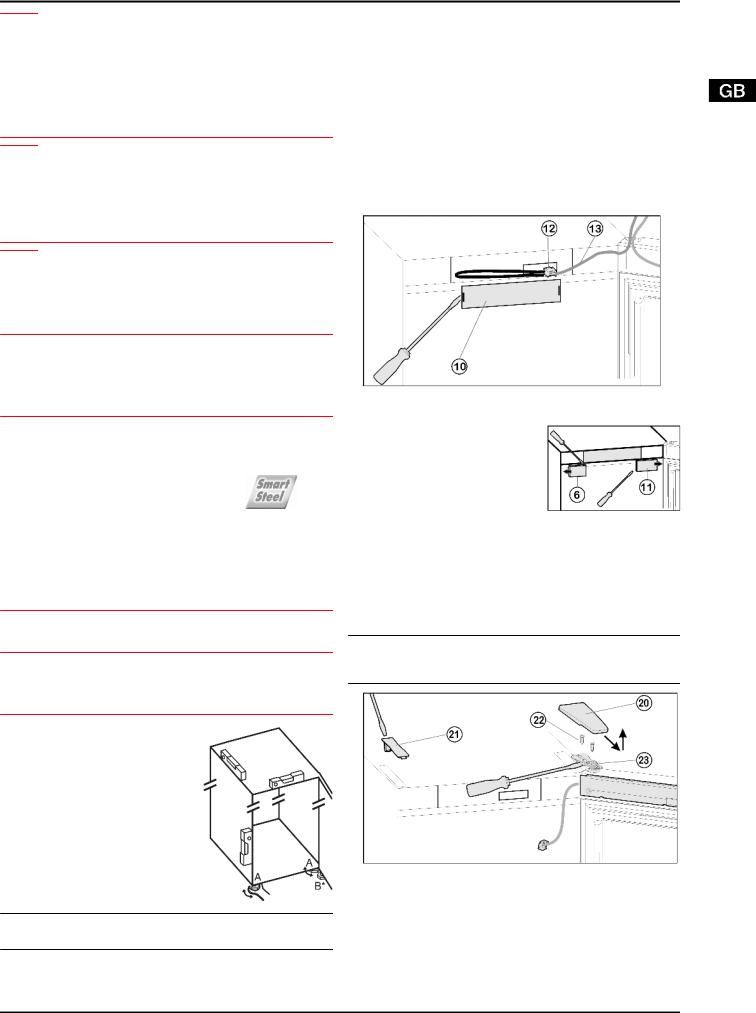
Putting into operation
 WARNING
WARNING
Fire hazard due to dampness!
If live parts or the mains lead become damp this may cause short circuits.
u The appliance is designed for use in enclosed areas. Do not operate the appliance outdoors or in areas where it is exposed to splash water or damp conditions.
 WARNING
WARNING
Fire hazard due to refrigerant!
The refrigerant R 600a is environmentally friendly but flammable. Escaping refrigerant may ignite.
u Do not damage the piping of the refrigeration circuit.
 WARNING
WARNING
Fire hazard and danger of damage!
u Do not place appliances emitting heat e.g. microwaves, toasters etc. on the appliance!
u Detach the connecting cable from the rear of the appliance, removing the cable holder at the same time because otherwise there will be vibratory noise!
u Remove the protective film from the outside of the appliance.
NOTICE
The stainless steel doors are provided with a high-quality surface coating and must not be treated using the accompanying care product.
Otherwise the surface coating will be affected.
u Wipe the coated door surfaces using a soft, clean cloth only.
u Apply a stainless steel cleaner only to the stainless steel side walls evenly, wiping with the grain. Subsequent cleaning becomes easier as a result.
u Wipe side walls with a paint finish using a soft, clean cloth only.
uRemove all transit supports.
uDispose of packaging material (see 4.5) .
NOTICE
Risk of damage due to condensate!
u Do not install the appliance directly alongside a further refrigerator/freezer.
u Align the appliance so that it stands firmly and on a level by applying the accompanying spanner to the adjustableheight feet (A) and using a spirit level.
u Then support the door: Extend the adjustable foot at the turn hinge (B) until it rests on the floor and then make a further 90° turn.
Note
u Clean the appliance (see 6.2) .
If the appliance is installed in a very damp environment, condensate may form on the outside of the appliance.
u Always see to good ventilation at the installation site.
4.3 Changing over the door hinges
You can change over the door hinges if necessary.
Ensure that the following tools are to hand:
q Torx® 25
q Torx® 15 q Screwdriver
q Cordless screwdriver, if necessary
q Second person for fitting work, if needed
4.3.1 Releasing the cable connection on the housing
Fig. 4 |
|
u Open the upper door, if necessary. |
|
u To remove the cover on the |
|
handle side Fig. 5 (6): disen- |
|
gage using a screwdriver on |
|
the right and slide outwards. |
|
u To remove the cover on the |
|
hinge side Fig. 5 (11): disen- |
|
gage using a screwdriver on |
|
the left and slide outwards. |
Fig. 5 |
uRemove the front panel Fig. 4 (10) using a flat-blade screwdriver.
uTake out the contact and disconnect the plug connection
Fig. 4 (12).
uDetach grey cable Fig. 4 (13) from the guide.
4.3.2 Detaching the upper door
Note
u Remove any food from the door racks before removing the door, so that no food falls out.
Fig. 6
uDraw the cover Fig. 6 (20) forwards and lift it off.
uLift off the cover Fig. 6 (21).
5
